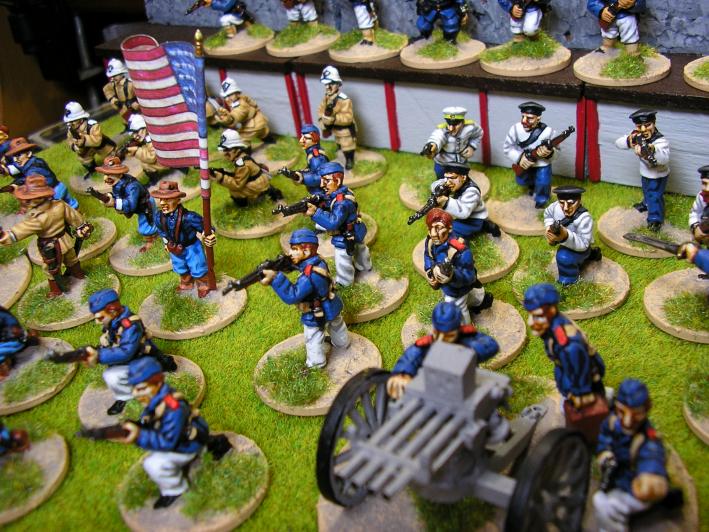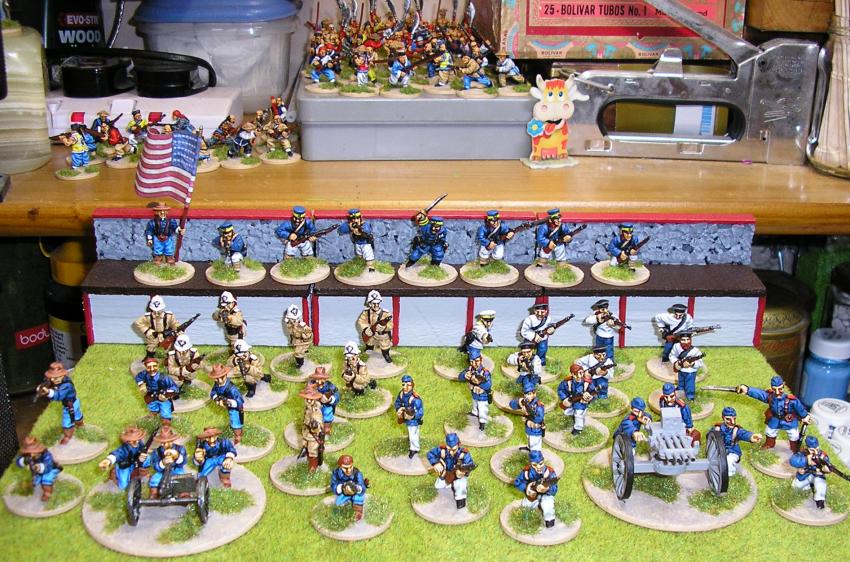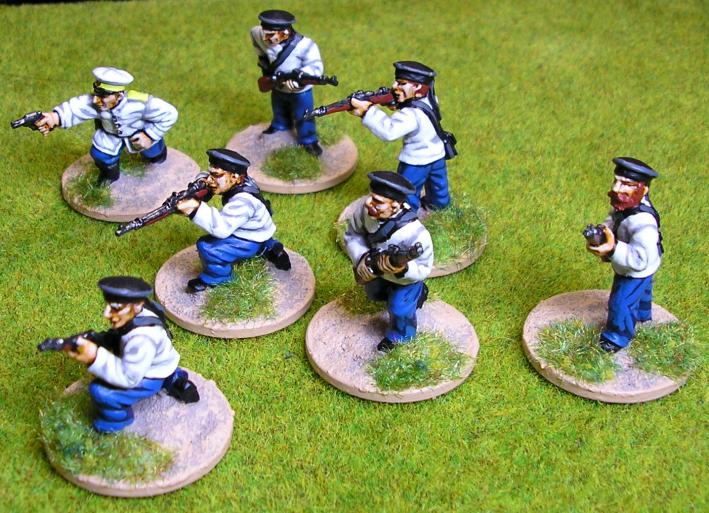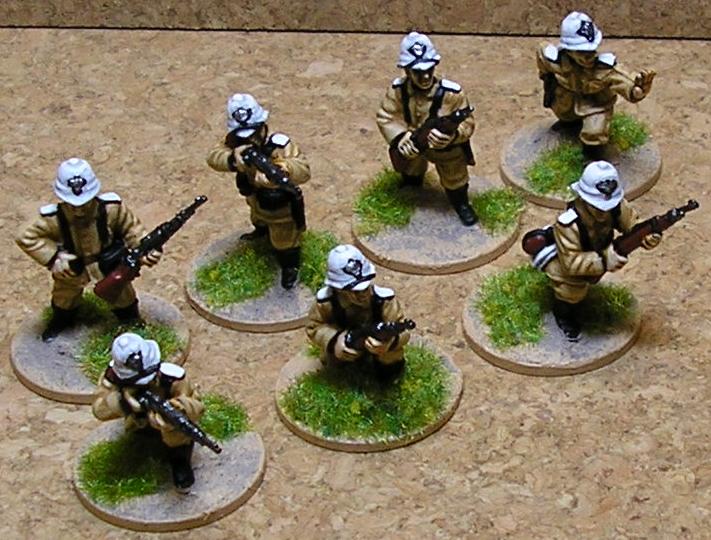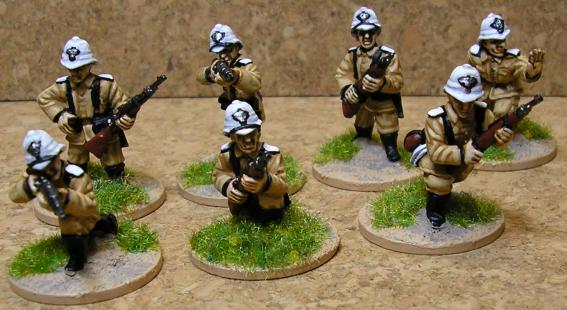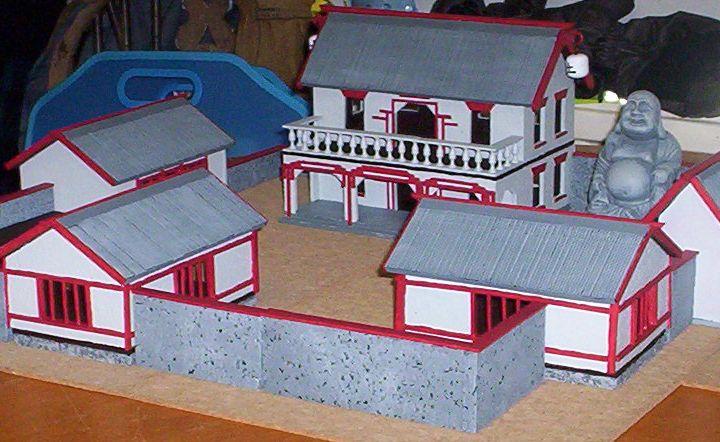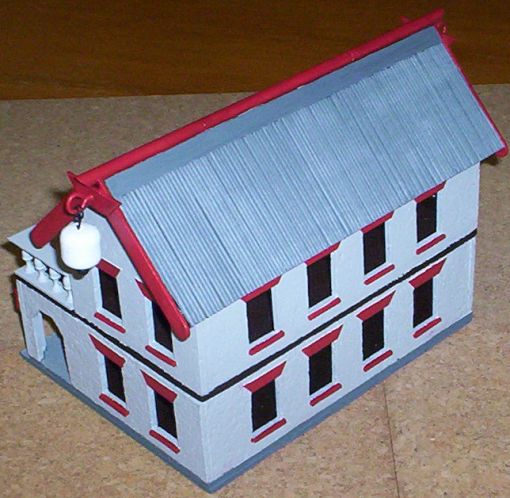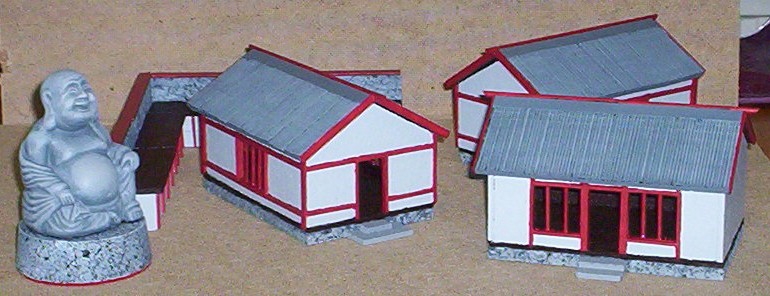|
The Natives are Restless Tonight
Simple rules for a Colonial siege skirmish game. Basic Premise This is a game designed to recreate a beleaguered colonial garrison under attack by ferocious natives. The defenders must try to survive until the relief column arrives whilst the attackers must attempt to wipe out the defenders and free their country from the imperialist overlords. The game is designed for 28mm figures and all ranges and distances are given with this in mind. The game can be played with virtually any figures from the colonial period: Zulu War, Boxer Rebellion, Foreign Legion, North West Frontier, Indian Mutiny etc… Equipment Playing area 4’ x 4’. Several D6. 2 Average dice (Dav). Figures, based individually. Buildings and barricades to represent a defensible structure in the centre of the playing area and to provide some cover for attackers. A deck of normal playing cards with 2 Jokers. Some type of counters to represent ammunition supplies for the defenders. Set up Place the buildings and walls/barricades that will make up the defenders’ area in the centre of the playing board, this should cover an area roughly 18” x 18”. There should be at least two entry/exit points. See photo for an example. Place some other terrain pieces, bushes, trees, walls etc. around the rest of the table to give some cover to the attackers. The area outside the defenders’ compound should provide sparse cover; the attackers should have to cross areas of open ground to reach the defenders. The defending player should place his forces inside his compound. The attacking player should roll the dice to determine his starting forces. Defending forces The Colonial forces should consist of 4-6 squads of men. A squad is composed of six men and an Officer/NCO. The more squads the defender is allowed the easier his task will be. Squads must be placed so that it is clear which figures are in which squads. The defender should also have a machine gun or small field gun with a crew of 4 figures. The defending player will need 20 rifle ammunition counters and 5 machine gun/field gun ammunition counters. He will also need a marker figure to represent the relief column, a standard bearer or bugler figure is recommended. Attacking forces The attacking player needs lots of natives armed with melee weapons. Some natives need to be better equipped than the standard troops, either with guns, or mounted or fanatical. Basic natives will operate in groups of 4-10 figures. Better troops will operate in groups of 2-5. At the beginning of the game the attacking player will roll randomly for his starting forces. He may roll once for each board edge to determine what figures enter from that side. The attacker rolls 2Dav and 1D6 (2 average dice and 1 six sided) If the D6 is a six the group of figures will be better quality troops than standard and he will get a number of figures equal to the higher of the two average dice. If the D6 is not a six he will get a group of figures equal to the sum of the average dice totals. The groups of natives may be placed anywhere along their starting board edge so long as they are kept together as a group. Example: The average dice are rolled and come up with the scores 4 and 3 and the D6 is a 6. The attacker will get a group of 4 better quality troops. If the dice had scored the same but the D6 was not a 6, he would get a group of 7 regular quality troops. Unit Activation Drawing a card from the face down deck activates groups of figures, either a defending squad, a group of natives or a machine gun/ field gun. Defenders are activated by black cards; natives by red cards. Cards numbered 2-10 allow any single group of the controlling player’s choice to take an action. Basic actions are ‘move’ or ‘fire’. Special actions can be carried out as circumstances dictate, for example, setting fire to a building or pulling down a barricade, each of these would be a single action. A picture card allows the player to take two actions, either a single action taken by each of two groups or one group may do two actions consecutively. After the player has finished carrying out his actions any melees are resolved. If there are no melees to resolve the native player will roll for reinforcements regardless of whether the picture card was black or red. An ace allows three actions to be taken and then either melees are resolved or the native player will roll for reinforcements as above. If the Ace of Spades is drawn, everything happens as above and, in addition, the defender may place his relief column marker on the board to signify that the column has been sighted or heard. (This is purely a status marker and cannot attack or be attacked etc.) If the Ace of Spades is drawn again the column arrives and the defending player has won the game. If a Joker is drawn the attacking player gets automatic reinforcements on each side of the board, determined in the same way as at the start of the game. In addition, the deck of cards is reshuffled. Neither player may take any actions when a Joker is drawn and melees are not resolved. If the relief column has been sighted and the flag marker is on the board only the next Joker to be drawn causes a reshuffle so that the Ace of Spades is returned to the deck. Subsequent Jokers allow reinforcements for the Native player as above but do not initiate a reshuffle. Movement Figures can move in any direction and may end up facing in any direction. Native figures in a group may not combine with other groups. Colonial groups that have got too small to be effective may be combined as an action if they are within 6” of each other. One Officer/NCO must be replaced permanently with a normal figure and the resulting group cannot number more than six men and a single Officer/NCO. Mounted figures may combine in this way with an infantry squad but they will become infantry too. Colonial figures on foot move 6”. Movement is carried out by measuring the move for the Officer/NCO and then arranging the members of his squad around him as necessary. Figures should be kept together so there is no difficulty in determining which squad they belong to. They may be grouped to occupy a room or spread out to man a section of wall etc. Moving from a floor in a building to any other floor in the same building (or the roof) is a full move. Figures in the same room as a door may leave a building, if they do so the move is measured from the door. It is a full move to cross a linear obstacle such as a barricade or wall. A defended obstacle cannot be crossed until all defenders are removed, either killed or pushed back. Mounted colonial troops move 12”, measured by the Officer/NCO. It costs them 6” of their move to cross an undefended linear obstacle. Any obstacle higher than a figure, for instance a high wall, is impassable to mounted troops. Defender's machine guns or field guns may not move position during the game. They may change their facing to any direction as a move action if they are fully crewed. If one or more crew members have been killed the defending player may use an action to remove a figure from a squad and replace one of the missing gun crew. It costs one action for each replaced crewman. A crewman may become an infantryman again if the gun is out of ammunition and there is a squad with room for him, this uses an action. Native troops move 8”. Their movement is carried out by measuring the move distance of a single figure and grouping the rest around him at the end of the move. Any figure can be chosen as the initial mover, it doesn’t have to be the same one each time. Native movement is more ‘elastic’ than that for Colonial troops. Mounted native troops move 12”. It costs 6” of their move to cross a low undefended linear obstacle (less than the height of a figure). Their movement is carried out by measuring the move for any figure of the controlling player’s choice and grouping the rest around him. The attacking player may use an action to remove any one of his groups from the playing area. The figures are immediately removed and become available to be deployed again. Shooting Figures (except the machine gun or field gun) may fire in any direction. Machine gun/ field gun have a firing arc of +/- 45* from their facing. Figures may shoot at any enemy they can see, the game is set in a small area and everything is considered in range. High walls, buildings, trees etc. block line of sight, Figures behind a stand of trees cannot be seen, and figures in a stand of trees receive the benefits of hard cover. Friendly forces also cannot be fired through. Figures in a group do not block each other’s fire. Line of sight is determined for the defenders by tracing it form the Officer/NCO to any member of the target group. LOS for the attackers is from any member of the shooting group to the enemy Officer/NCO. Firing is carried out by selecting an enemy group to shoot at. A D6 is rolled for every figure in the firing group and these dice are totaled together. The results are applied as follows with the non-shooting player deciding which particular figures are removed. Officers/NCO are always the last figures to be removed from a squad. Machine guns and field guns roll 8 dice when they fire. This total is reduced by two dice for each crewman lost. Every multiple of 6 will kill an enemy in the open. Every multiple of 9 will kill an enemy protected by ‘soft’ cover. (Bushes, dead animals etc.) Every multiple of 12 will kill an enemy protected by ‘hard’ cover. (Inside a building, behind a barricade or wall, in trees etc.) All casualties are removed immediately. Optional Range rule Any target that is 24” or more away counts as long range and requires the following totals to kill: In the open 9 Light cover 12 Hard cover 18 Example: A full squad of colonial troops defending a wall decide to shoot at a group of nine natives running towards them across open ground. The squad rolls 7D6 (six men and an Officer) and scores 6, 5, 2, 2, 3, 4, 1, a total of 23, that’s 3 lots of 6 and 5 left over. Three natives hit the dirt dead. One more point and another would have joined them. If the natives had been hiding in some rocks, (hard cover), only one would have died, one 12 and only 11 left, not enough for a second kill. Ammunition use Supplies are limited for the defenders, each time a squad fires, regardless of the number of figures in it, the defending player must discard an ammunition counter. Each time the machine gun or field gun fires one of those ammunition markers must be discarded. Optional Ammunition Rule: If you are playing a game with an Umpire, the Umpire should keep track of the ammunition usage and tell the defending player when it is getting low. To avoid the defending player having too much awareness of his ammunition supply, the Umpire may want to remove 1D6 counters before the game. Dropping expended ammunition counters loudly into a container as they are used greatly increases the tension for the defending player and encourages the attacker. You may like to use spent rifle casings as markers, they have an ‘authentic’ sound. Morale The defenders never have to worry about their morale; they have nowhere to run to. Natives, on the other hand, do and so must check morale each time they suffer casualties. The native player rolls 1D6 when a group suffers any losses and must roll over the number of casualties inflicted or the group will rout. If a rout occurs the group is immediately removed from play and becomes available for recycling as reinforcements. Fanatical troops never test for morale. Melee When opposing groups come into contact a savage hand-to-hand battle will ensue. Once engaged in a melee groups may not break off. Melees are not resolved until a picture card or an Ace is drawn, this adds to the uncertainty and allows participants with guns to maybe get off a shot or two before everything is decided. Groups outside a melee may not fire into it. Once a melee has started other groups may be fed into it to bolster numbers. Native forces will combine into one big group and split into groups by type at the end, all basic troops will form one group, all mounted will form another and all special troops will form groups according to type. Colonial forces that survive will form squads again composed as the controlling player wishes. Melees are resolved by rolling a D6 for each combatant and totaling them. Results are applied as follows. Each multiple of 6 will kill an enemy in the open Each multiple of 9 will kill an enemy defending a hasty barricade. Each multiple of 12 will kill an enemy defending a building or prepared position. Hand-to-hand fighting is considered to be simultaneous so, although it is recommended that you resolve a melee by one player rolling and then the other, casualties should not be removed until they’ve had a chance to roll their own attacking dice. Native forces that suffered casualties may need to take a morale test, this is done before the winner and loser of a melee is decided. Natives that have killed all the figures opposing them in hand-to-hand combat do not have to take a morale test. If the natives flee then the defending players forces are considered to have won the melee so that they do not have to retreat from their defensive positions. If both sides have figures left after the melee is resolved then the side that lost the most figures is considered the loser and must fall back a full move and regroup. If both sides lost the same amount then the side with the least number of figures remaining is considered the loser. If both sides have taken equal casualties and have the same number of figures remaining then the defender is considered the winner. The winner may move forward to occupy any positions that the loser previously held and form his groups there. This means a successful attacker will cross a previously defended barricade/obstacle. Figures defending a building that are forced back must exit the building away from the attackers (possibly through windows etc.) Native reinforcements Each time a picture card or an Ace is drawn and there are no melees to be resolved the attacking player gets to roll to see if more natives turn up. Assign a number 1-4 to each table edge and roll 1D6. If you roll 1-4 that is the side reinforcements will appear on, if you roll 5 or 6 none appear. If reinforcements are indicated, then roll 2Dav and 1D6 as at the start of the game and place the resulting group anywhere along their starting edge. Reinforcement rolls are done after any actions so they will not get to do anything straight away. Winning The defending player wins if the relief column arrives, the attacking player wins if he kills all the defenders. Sample army Here are examples of the figures needed for a game set in the Boxer Rebellion. Attacking Forces 60 Boxers armed with a variety of swords and pole arms. 20 Boxers armed with muskets, a better quality element of the force. 20 Tiger Men who are counted as fanatical, a better quality element. 1 Field Gun with 4 crew. A better quality element that can be taken if there is a five on the ‘number of figures’ die. Special rule for Attacker's field guns Field guns may move as infantry until they are fired. Once they have fired they may not move for the remainder of the game. Field guns roll 8 dice when they fire, losing 2 dice for each lost crewman. If they are contacted by the enemy and the entire crew is either dead or missing the gun is considered destroyed and is removed from play. Defending Forces 1 Squad of US Marines consisting of 6 men and an Officer. 1 Squad of British Marines consisting of 6 men and an Officer. 1 Squad of Japanese Marines consisting of 6 men and an Officer. 1 Squad of Russian Sailors consisting of 6 men and an Officer. 1 Squad of German Seebattalion consisting of 6 men and an Officer. 1 US Colt machine gun and crew. 1 Relief column marker consisting of a US Marine standard-bearer. |






